
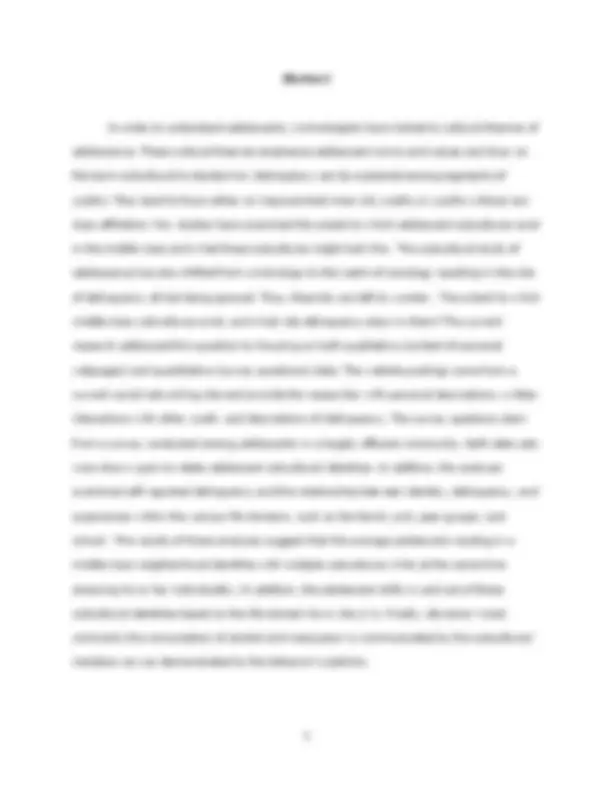

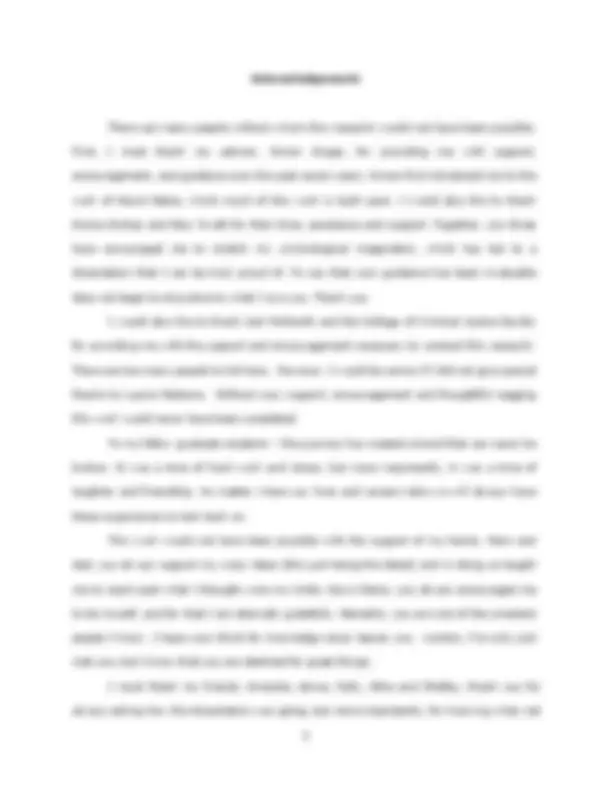
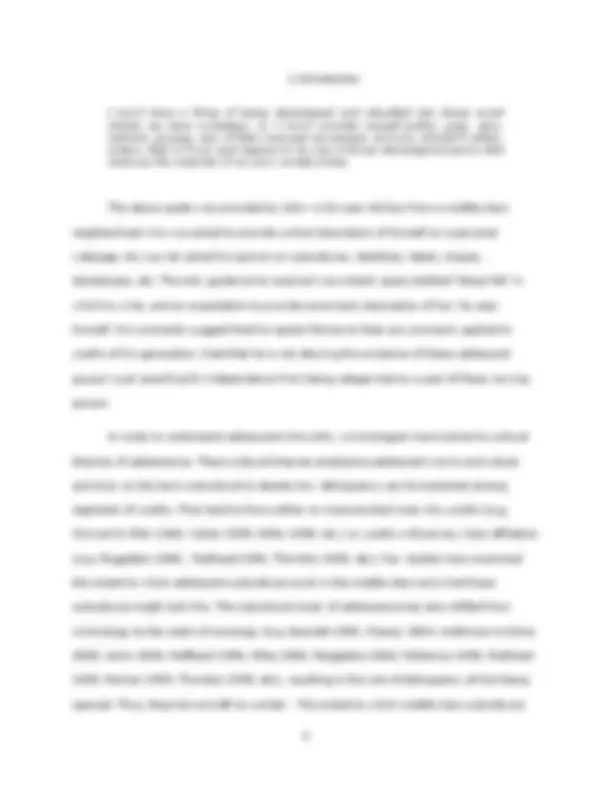

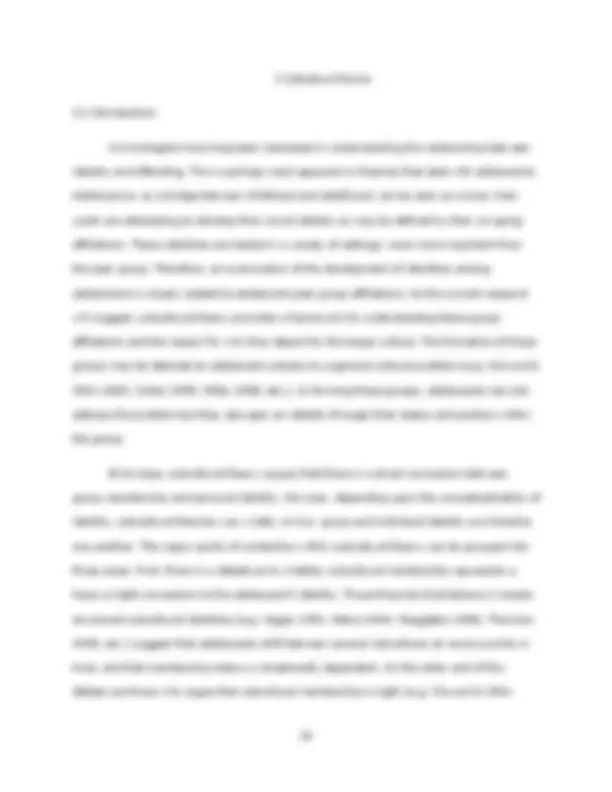



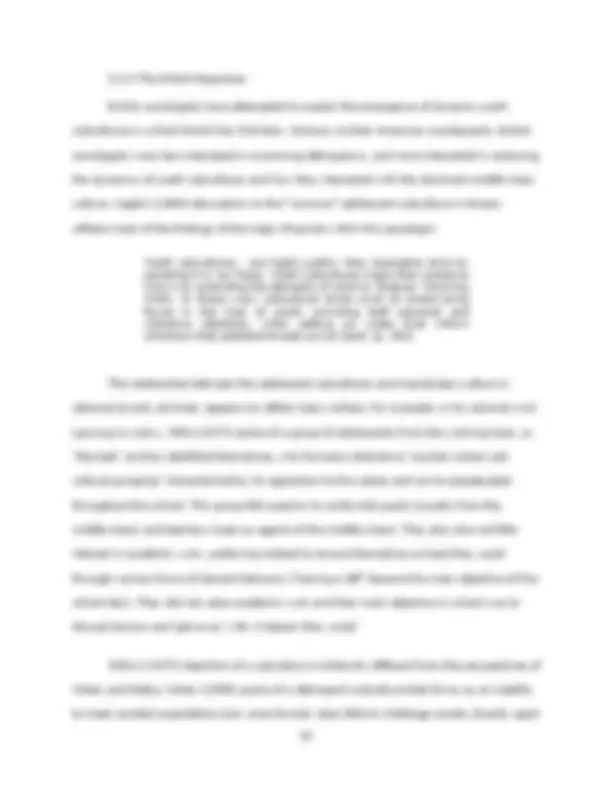





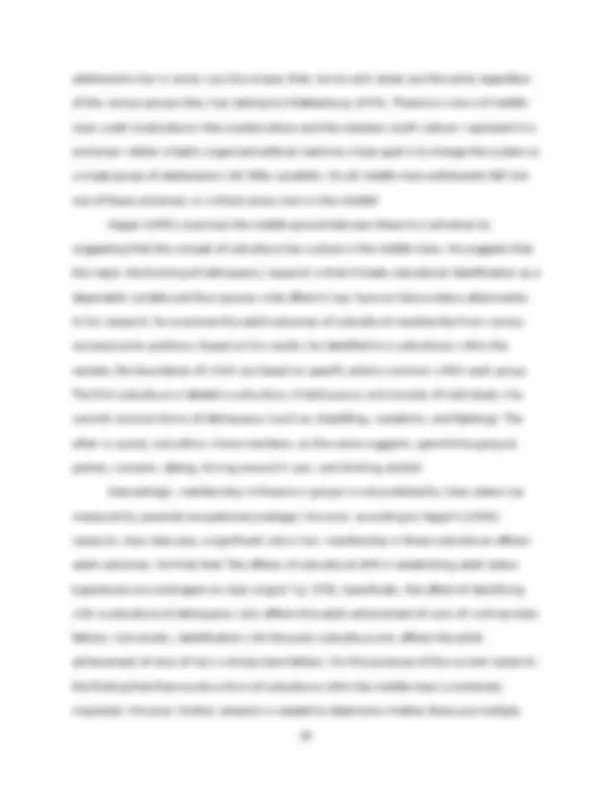

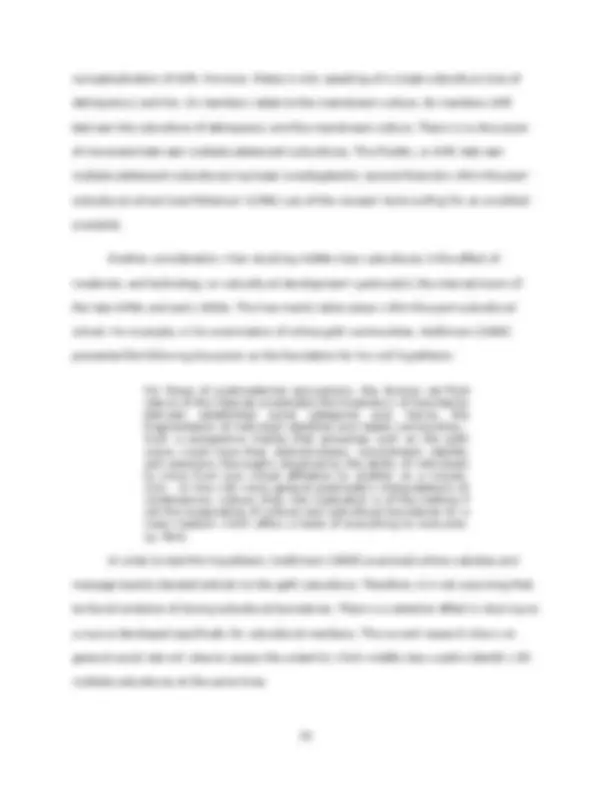
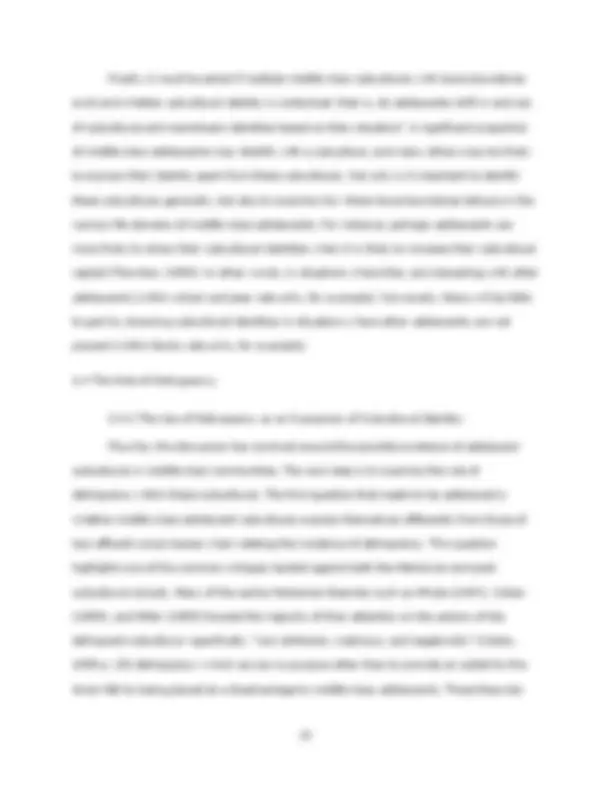




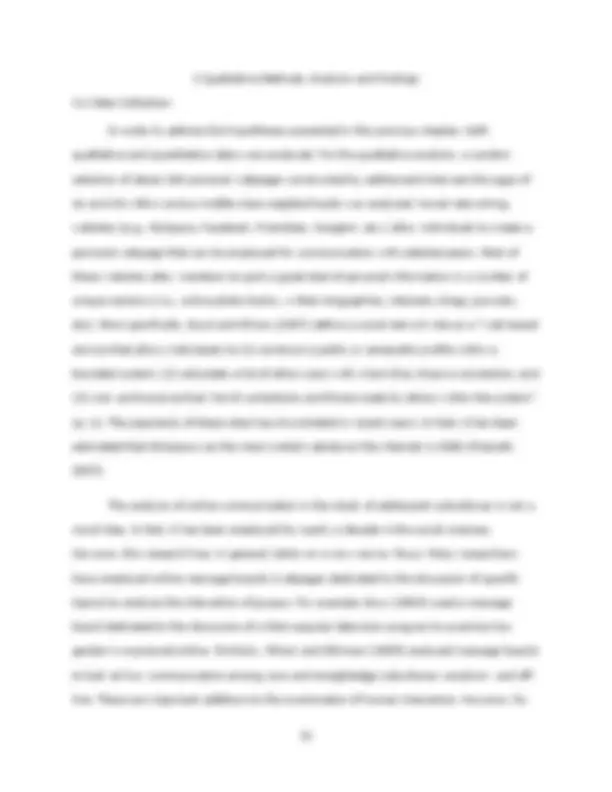













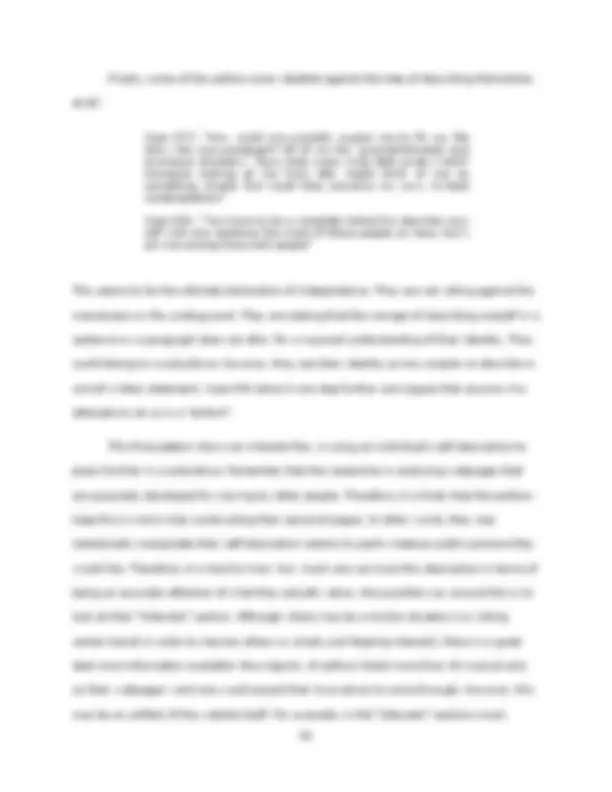



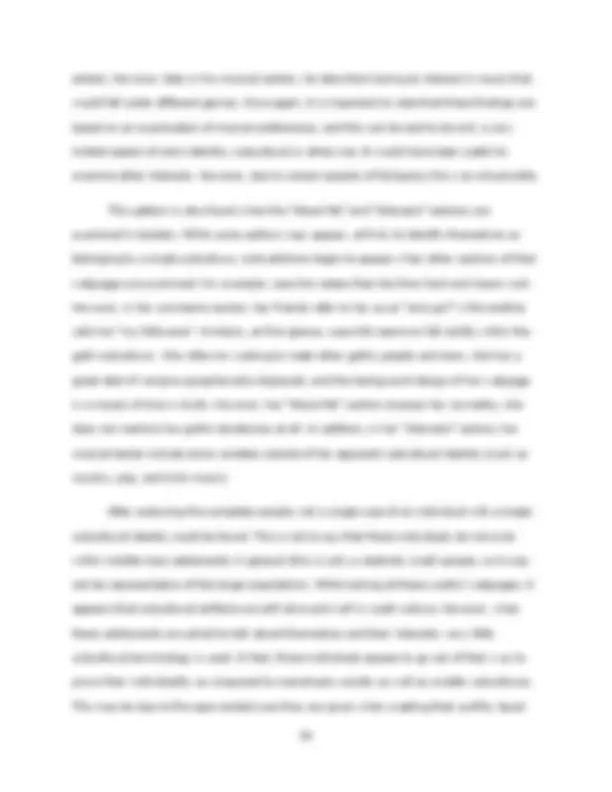






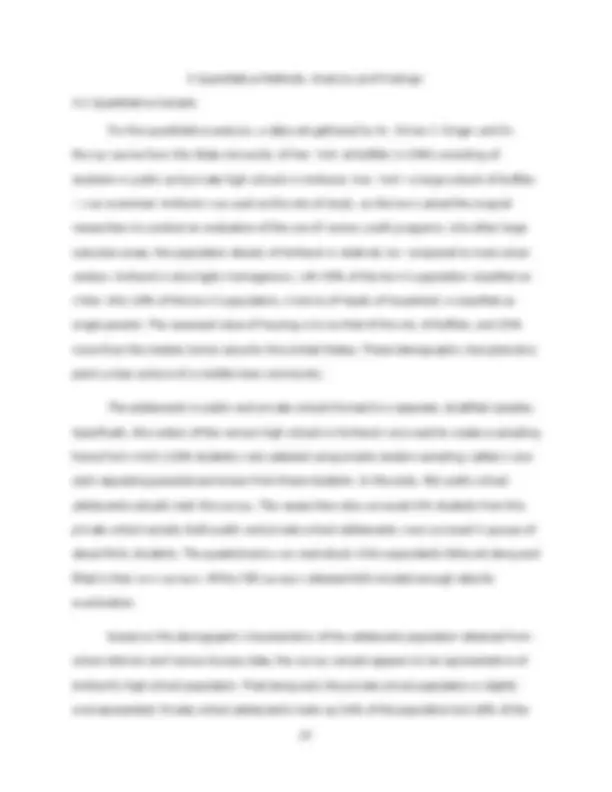


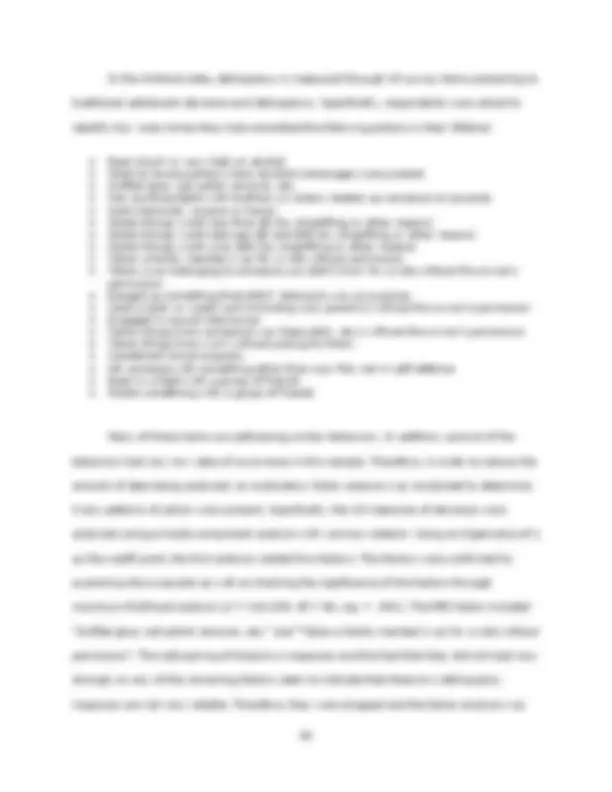

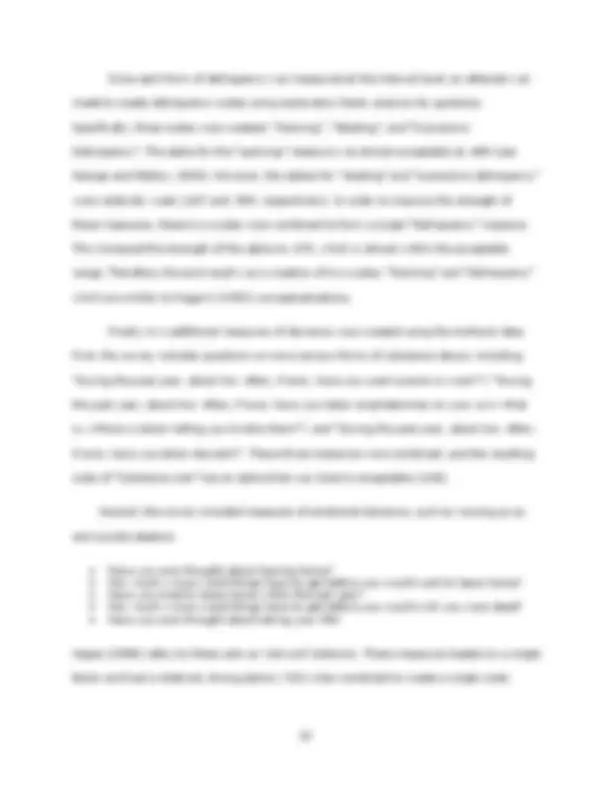



























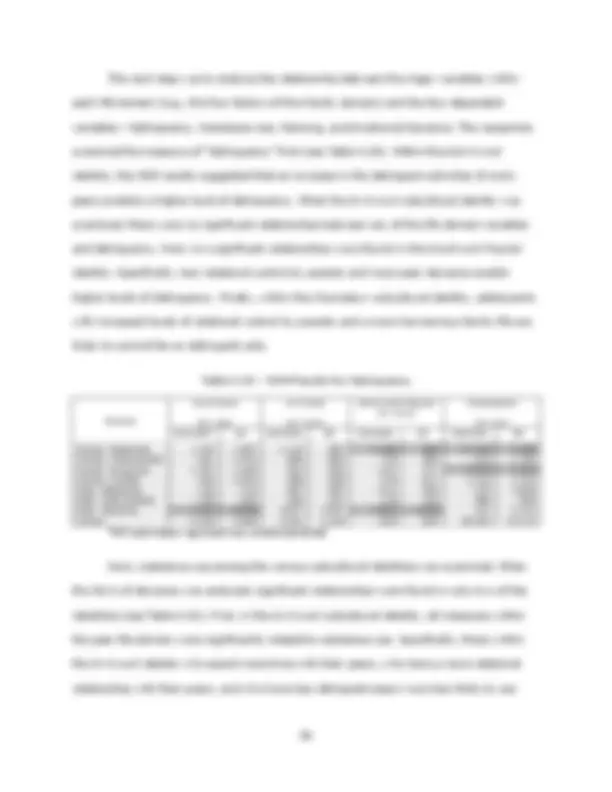

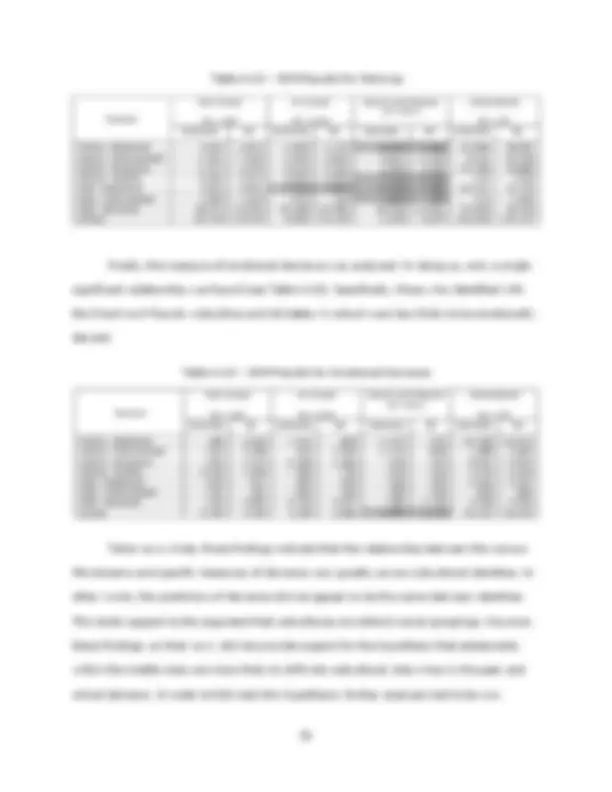



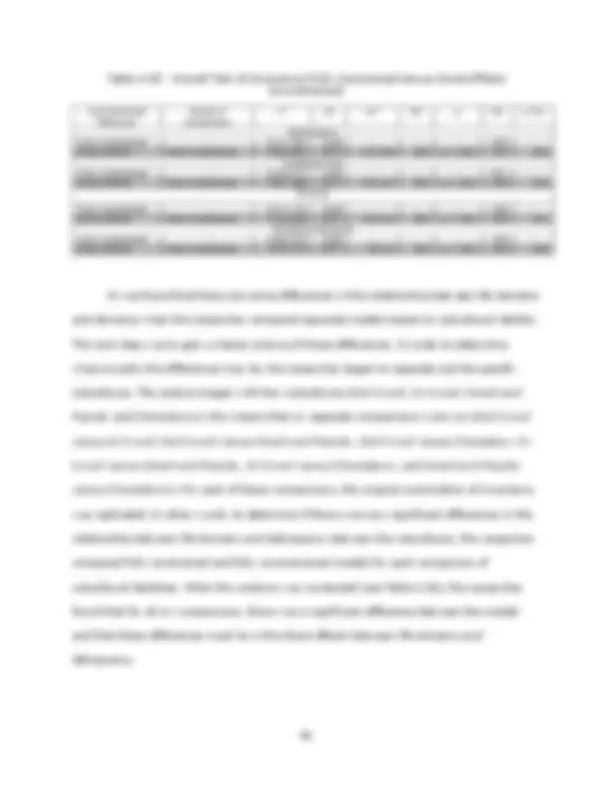

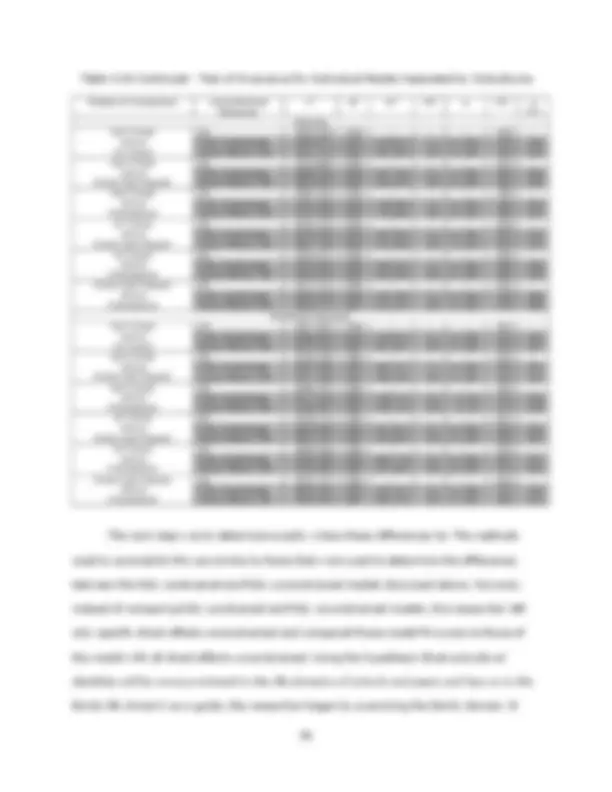
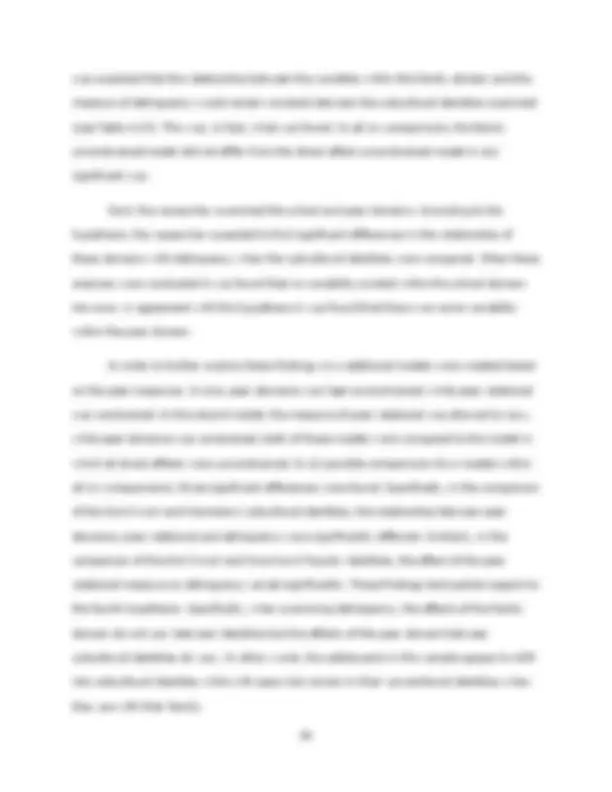



Study with the several resources on Docsity

Earn points by helping other students or get them with a premium plan


Prepare for your exams
Study with the several resources on Docsity

Earn points to download
Earn points by helping other students or get them with a premium plan
Community
Ask the community for help and clear up your study doubts
Discover the best universities in your country according to Docsity users
Free resources
Download our free guides on studying techniques, anxiety management strategies, and thesis advice from Docsity tutors
A research study that investigates the relationship between subcultural identities and delinquency among middle-class adolescents. The study examines how these identities are expressed across various life domains, such as family, peers, and school, and whether they are all-encompassing or if adolescents drift in and out of them. The research also explores the role of social class and delinquency in the development of subcultural identities.
What you will learn
Typology: Thesis
1 / 127

This page cannot be seen from the preview
Don't miss anything!





























































































A dissertation presented by Adam Monroe Stearn to The School of Criminology and Criminal Justice
In partial fulfillment of the requirements for the degree of Doctor of Philosophy in the field of Criminology and Criminal Justice Northeastern University Boston, Massachusetts January, 2012
by Adam Monroe Stearn
Submitted in partial fulfillment of the requirements for the degree of Doctor of Philosophy in Criminology and Criminal Justice in the Graduate School of Arts and Sciences of Northeastern University, January, 2012
Dedication
For Jenna. You have done more for me than I could ever hope to give back. Thank you.
Acknowledgements
There are many people without whom this research would not have been possible. First, I must thank my advisor, Simon Singer, for providing me with support, encouragement, and guidance over the past seven years. Simon first introduced me to the work of David Matza, which much of this work is built upon. I would also like to thank Donna Bishop and Marc Swatt for their time, assistance and support. Together, you three have encouraged me to stretch my criminological imagination, which has led to a dissertation that I can be truly proud of. To say that your guidance has been invaluable does not begin to do justice to what I owe you. Thank you. I would also like to thank Jack McDevitt and the College of Criminal Justice faculty for providing me with the support and encouragement necessary to conduct this research. There are too many people to list here. However, I would be remiss if I did not give special thanks to Laurie Mastone. Without your support, encouragement and thoughtful nagging this work would never have been completed. To my fellow graduate students – this journey has created a bond that can never be broken. It was a time of hard work and stress, but more importantly, it was a time of laughter and friendship. No matter where our lives and careers take we will always have these experiences to look back on. This work would not have been possible with the support of my family. Mom and dad, you always support my crazy ideas (this just being the latest) and in doing so taught me to reach past what I thought were my limits. Dawn-Marie, you always encouraged me to be myself, and for that I am eternally gratefully. Memphis, you are one of the smartest people I know. I hope your thirst for knowledge never leaves you. London, I’ve only just met you, but I know that you are destined for great things. I must thank my friends. Amanda, Jenna, Kelly, Mike and Shelley, thank you for always asking how the dissertation was going, but more importantly, for knowing when not
1 Introduction I don’t have a liking of being stereotyped and classified into these social clichés we have nowadays, so I don’t consider myself gothic, prep, emo, redneck, grunge, any of that overused excrement, and you shouldn’t either, unless, that is if you just happen to be one of those stereotypical peons that make up the majority of our poor society today.
The above quote was provided by John—a 16-year-old boy from a middle-class neighborhood who was asked to provide a short description of himself on a personal webpage. He was not asked his opinion on subcultures, identities, labels, cliques, stereotypes, etc. The only guidance he received was a blank space entitled “About Me” in which to write, and an expectation to provide some basic description of how he sees himself. His comments suggest that he rejects the terms that are commonly applied to youths of his generation. Note that he is not denying the existence of these adolescent groups—just asserting his independence from being categorized as a part of these varying groups.
In order to understand adolescents like John, criminologists have looked to cultural theories of adolescence. These cultural theories emphasize adolescent norms and values and draw on the term subcultural to denote how delinquency can be explained among segments of youths. They tend to focus either on impoverished inner-city youths (e,g, Cloward & Ohlin 1960; Cohen 1955; Miller 1958; etc.) or youths without any class affiliation (e.g. Muggleton 2000; Redhead 1990; Thornton 1995; etc). Few studies have examined the extent to which adolescent subcultures exist in the middle-class and what these subcultures might look like. The subcultural study of adolescence has also shifted from criminology to the realm of sociology (e.g. Bennett 1999; Chaney 2004; Hodkinson & Dicke 2005; Jenks 2004; Maffesoli 1996; Miles 2000; Muggleton 2000; Polhemus 1996; Redhead 1990; Reimer 1995; Thornton 1995; etc), resulting in the role of delinquency all but being ignored. Thus, theorists are left to wonder: The extent to which middle-class subcultures
2 Literature Review
2.1 Introduction:
Criminologists have long been interested in understanding the relationship between identity and offending. This is perhaps most apparent in theories that deal with adolescents. Adolescence, as a bridge between childhood and adulthood, can be seen as a time when youth are attempting to develop their social identity as may be defined by their on-going affiliations. These identities are tested in a variety of settings, none more important than the peer group. Therefore, an examination of the development of identities among adolescents is closely related to adolescent peer group affiliations. As the current research will suggest, subcultural theory provides a framework for understanding these group affiliations and the reason for why they depart for the larger culture. The formation of these groups may be deemed an adolescent solution to a general cultural problem (e.g. Cloward & Ohlin 1960; Cohen 1955; Miller 1958; etc.). In forming these groups, adolescents not only address the problem but they also gain an identity through their status and position within the group.
At its base, subcultural theory argues that there is a direct connection between group membership and personal identity. However, depending upon the conceptualization of identity, subcultural theories vary widely on how group and individual identity are linked to one another. The major points of contention within subcultural theory can be grouped into three areas. First, there is a debate as to whether subcultural membership represents a loose or tight connection to the adolescent’s identity. Those theorists that believe in loosely structured subcultural identities (e.g. Hagan 1991; Matza 1964; Muggleton 2000; Thornton 1995; etc.) suggest that adolescents drift between several subcultures at various points in time, and that membership status is situationally dependent. On the other end of this debate are those who argue that subcultural membership is tight (e.g. Cloward & Ohlin
1960; Cohen 1955; Miller 1958; etc.). These theorists believe that adolescents gain their identity from subcultural membership. In addition, these theorists argue that subcultural memberships are impermeable; the adolescent can only belong to a single subculture at a single point in time. This point of contention is closely related to whether the theorist is examining the adolescent’s identity from the individual’s perspective or the group’s. Specifically, those theorists who analyze adolescents’ self-identification of subcultural membership (e.g. Hebdige 1984; Muggletone, 2000; Polhemus 1996; Thornton 1995; etc.) have found that the adolescent’s identity is only loosely connected to the subcultural group. Conversely, those theorists who operationalize subcultural membership through certain structural characteristics, such as class and race (e.g. Cloward & Ohlin 1960; Cohen 1955; Miller 1958; Wolfgang and Ferracuti 1967; etc.), have found that the adolescent’s identity is tightly connected to subcultural membership. These theorists argue that subcultural membership is absolute and thus the individual’s identity all but disappears into the group’s identity. Thus, when examining subcultural membership an analysis of individual identity would be redundant
The second major area of contention among subcultural theories concerns delinquency. In the past few decades, the concept of adolescent subcultures has moved into the realm of sociology. This had led to fascinating studies of group dynamics and the position of adolescents within society (see Hebdige 1984; Jenks 2004; Maffesoli 1996; Muggleton 2000; Thornton 1995; and Ueno 2003). However, the role of delinquency has been largely ignored (e.g. Muggleton 2000; Redhead 1990; Thornton 1995; etc.). In contrast to these sociological studies, the criminological study of subcultures sees delinquency as a means towards group status (e.g. Cloward & Ohlin 1960; Cohen 1955; Matza 1964; etc.). The focus of the current research will be on the criminological, with a goal to further the understanding of how delinquency and subcultural identity are related to one another.
In 1947 Gordon presented the first clear definition of subculture. He defined a subculture as: “A sub-division of national culture, composed of a combination of factorable social situations such as class status, ethnic background, regional and rural or urban residences, and religious affiliation, but forming in their combination a functioning unity which has an integrated impact on the participating individual” (p. 40). Gordon’s (1947) definition directed attention to the structural characteristics of the individual. While he did acknowledge that a specific subculture can have an effect on the individual member, he was less than clear about what this effect might be.
Gordon’s (1947) definition associates structural characteristics with the boundaries of a subculture. For example, if one were to argue that all African-American males from urban, lower-class backgrounds who are between the ages of 14 and 19 comprise a single subculture, then, by definition, anyone with characteristics that differ from these must belong to a different subculture. Thus, it is clear that the first attempt to clarify the concept of subculture led to a conceptualization of a subculture as a tightly bound, structurally defined social unit. Similar to the early work of the Chicago school, no consideration was given to the individual members’ identities.
2.2.2 The Mertonian School: A Delinquent Subculture Cohen (1955) and Cloward and Ohlin (1960) specifically related the reasons for delinquency to a delinquent subculture. They based their subcultural theories upon Merton’s (1938) theory of anomie, which argues that the strain originating from the disconnect between the societally prescribed goals and individual means to achieve these goals leads to crime. Cohen (1955) and Cloward and Ohlin (1960) expanded on this concept by arguing that delinquency is a subcultural solution to these strains experienced by lower-class youth. Specifically, these theorists focused on the disconnect between larger societal goals and the available means of lower-class youths in achieving those goals. The solution for their adolescent problems resided in a type of delinquent subculture. The types of delinquent
subcultures exist because of the need for status, which can be obtained through the formation of delinquent groups that replace dominant middle-class objectives with more achievable ones. These groups, according to Mertonian theorists, create their own norms, different from, but not in complete opposition to those of middle-class society. Once they belong to these groups, delinquent youths feel less of a need for conforming to the values of the larger society.
In his book, Delinquent Boys, Cohen (1955) identified the characteristics of a delinquent subculture. He argued that the major identifying characteristic of the delinquent subculture is how it responds to the middle class: “The delinquent subculture… permits no ambiguity of the status of the delinquent relative to that of anybody else” (p. 131). This suggests that once subcultural affiliation begins that it remains integral to an adolescent’s identity. Like Gordon’s conceptualization of subcultural boundaries based on structural characteristics such as race, Cohen’s analysis demarcates subcultural affiliation based on fixed characteristic, status frustration and delinquency. These are not likely to change for the lower-class youth.
Three years later, Cohen and Short (1958) expanded upon the ideas presented in Delinquent Boys (Cohen, 1955) by arguing that there are, in fact, several adolescent subcultures. While a discussion of the specific distinctions between these subcultures is not relevant to the current analysis, it is important to acknowledge that Cohen and Short were attempting to create a more complete typology of adolescent subcultures. Still, they asserted that subcultures were fixed affiliations demarcated around structural characteristics and that lower-class adolescents could only belong to one subculture at a time.
Cloward and Ohlin (1960) expanded upon Cohen’s (1955, 1958) work by arguing that in areas with high rates of delinquency there is a duality of norms. In these neighborhoods, there is a competition between criminal and conventional value systems.
conceptualization of a subculture is the first to appear in the criminological literature. In arguing that adolescents take on either delinquent or conventional identities depending upon the situation, Matza emphasizes the duality of conventional and non-conventional identities. He describes the “typical” delinquent as “[A]n actor neither compelled nor committed to deeds nor freely choosing them; neither different in any simple or fundamental sense from the law abiding, nor the same; conforming to certain traditions in American life while partially unreceptive to other more conventional traditions (p. 28)
In order to explain how these seemingly contrary characteristics can exist within the same individual, Matza introduces the concept of drift. He argues that adolescents “exist in a limbo between convention and crime, responding in turn to the demands of each, flirting now with one, now with the other, but postponing commitment, evading decision” (p.28). Depending on the situation, the adolescent may experience an “episodic release from moral constraint” (p. 69). This release is what Matza refers to as drift. Drift means that in certain situations he or she is free to commit a delinquent act. The assumption, then, is that the adolescent's default is to conform -- but occasionally this conforming behavior is loosened and allows for some delinquent acts.
The question that remains is why are some adolescents committed to their delinquent acts when they are in a state of drift while others are not? Matza introduces the idea of a subculture of delinquency to explain this phenomenon. He states that “the values and norms implicit in the subculture of delinquency are obviously related to delinquencies, and these values and norms obviously depart in some manner from the conventional society” (p. 37). However, this subculture is not formed because of its members’ inability to meet society expectations. In fact, a subculture of delinquency receives its motivation from the conventional culture. Specifically, Matza and Sykes (1961) believe that conventional societies include many contradictory values that adolescents learn and use to justify
contradictions in their own behavior. Matza refers to these contradictory values as subterranean values:
Subterranean values [are] values… which are in conflict or in competition with other deeply held values but which are still recognized and accepted by many. [However] These contradictions… are not necessarily the opposing viewpoints of two different groups. They may also exist within a single individual and give rise to profound feelings of ambivalence in many areas of life. (p. 716)
Subterranean values suggest that delinquency is acceptable in certain situations— and it is in these situations that adolescents drift between conventional and delinquent identities.
The boundaries of a subculture in Matza’s conceptualization differ from the Mertonian school in two significant ways. First, Matza argues for a loose conceptualization of subcultures, suggesting that there is no delinquent subculture per se, only a subculture of delinquency to which youths subscribe from time to time, drifting between conventional and non-conventional identities. Adolescent identity is not based fully on his or her membership in the subculture. Second, Matza argues that although delinquency may be an important part of adolescence, it is not a defining characteristic. However, it cannot be said that Matza’s conceptualization of adolescent subculture is completely porous, as he is suggesting that adolescents must take on one of two identities at various moments of their lives—either as a conforming member of society or as a member of the subculture of delinquency. In addition, he says little about the possibility of subcultural identities that are less loosely configured than that which is applied by the term subculture of delinquency.
from acting out through their delinquency. Meanwhile, Matza (1964) introduced the concept of an adolescent subculture that drifts between the conventional and the delinquent, at times existing in both worlds. The British perspective, on the other hand, describes adolescent subcultures that exist in direct and explicit opposition to the mainstream culture. Willis presents another example of a subculture with tight boundaries based on structural characteristics. There is not only little movement between subcultures, but also outright hostilities between the two groups. While the British perspective focused on the general behaviors of subcultural members, a new school of the American perspective was developing that focused specifically on violence and delinquency. This subculture of violence will be discussed in detail in the following section.
2.2.5 The Subculture of Violence: Wolfgang and Ferracuti (1967) developed their theory of the subculture of violence to explain why certain subsets of the American population are more likely than others to resort to violence. Their theory differs from the previous formations discussed because it focuses on explaining violence among young impoverished urban black males. The authors argue that due to historical and cultural experiences, this disadvantaged group is overrepresented in homicide statistics. Members of a subculture of violence have a “‘counter-norm’ of nonviolence” (p. 158). Through socialization, subcultural adherents learn to resort to violence when faced with a perceived threat. The subculture of violence reproduces itself generation after generation. Compared to the theories put forth by Cohen (1955), Matza (1964) and the British school, Wolfgang and Ferracuti’s theory is an aggregate theory of violence. It is based on the incidence of violence among disadvantaged groups in certain geographical areas.
Anderson (2000) introduced a nuanced and focused version of the subculture of violence, drawing on his observations of an impoverished inner-city neighborhood. He draws on the term code of the streets to distinguish street from decent families and youths. Like
Wolfgang and Ferracutti’s (1967) conceptualization, street youths internalize the norm of responding to conflict with violence. In contrast, decent youths can be code switchers, traversing from one set of norms to the next. Code switching is similar to Matza’s conceptualization of drift. Depending on the circumstances, street youths are those who drift between conventional and less conventional societal values.
2.2.6 Post-Subcultural Theory Sociologists interested in subcultures have reached back to concepts first presented by Matza and developed a perspective that Redhead (1990) refers to post-subcultural theory. Post-subcultural theorists argue that subcultures “must be based upon an interpretation of the subjectively held meanings, values and beliefs of the subculturalists themselves” (Muggleton, 2000, p. 10). To locate the behaviors and motivations of adolescents in subcultures, the subjectively experienced place of youths must be understood. In other words, this method examines the subculture from within the group; these theorists attempt to operationalize adolescent subcultures through the self- identification of the subculture’s members. However, finding a common theoretical conceptualization of youth subcultures among post-subcultural theories is not a simple task. For example, many post-subculturalists disagree as to whether the term “subculture” is even appropriate. Terms such as ‘taste cultures’ (e.g. Thornton, 1995), ‘Neo-tribes’ (e.g. Bennett, 1999; Maffesoli, 1996; Ueno, 2003), and ‘lifestyles’ (e.g. Chaney, 2004; Miles, 2000; Reimer, 1995) have been used interchangeably to describe modern youth groups. Still others argue that the idea of a subculture is redundant since modernity has led to the complete fragmentation of culture (Chaney, 2004), and that this fragmentation has led to the creation of limitless groups—and that these groups do not differ significantly enough in their values and norms to be labeled as subcultures.
However, some post-subcultural theorists maintain a connection, albeit a rather loose one, with more traditional subcultural theory. This connection is apparent in